Marco Etheridge's Blog, page 10
June 16, 2018
Book Review: "The Sun Also Rises" by Ernest Hemingway
 The Sun Also Rises by Ernest Hemingway
The Sun Also Rises by Ernest HemingwayMy rating: 4 of 5 stars
Ernest Hemingway's "The Sun Also Rises," published in 1926, has been continuously in print for over nine decades. That, in itself, is a strong testament to any novel. I cannot say exactly how many times I have read this work, but I am going to guess at five readings. My lovely wife brought the book home from the library and, as it was just sitting there, I picked it up and read it. Why?
It has become fashionable, in the years following his death by suicide, to malign Hemingway's work. There are many reasons for this, most of which do not have much to do with his writing. A cult of personality has grown up around Hemingway's life, a cult of machismo, that of the hunter, the fighter, the fisherman, the man of many wives. Having read a good bit about his life, I believe that this cult of personality played a part in his undoing. He was a complicated public figure, a famous American novelist, a man of braggadocio and bluster. Infantilized by his mother, he overcompensating for that upbringing by embracing a facade of manliness that he would become famous for. But that is the writer, not the writing. Let us set that aside.
Hemingway subscribed to the "Iceberg Theory" of composing a novel. Using spare, simple prose, he told the tip of the tale, leaving the reader to plumb the depths of what lay beneath his stark words. It may not seem like a huge revelation now, but compare Hemingway's work to some of his contemporaries: Theodore Dreiser, Ford Madox Ford, John Dos Passos, all great writers who wrote deeply complex novels. "The Sun Also Rises," seems almost a novella by comparison. Yet below the deceptively simple descriptions, and direct dialogue, lies the bulk of the story. Hemingway's writing style has had a significant impact on modern novels. Because of that impact, as well as his impressive body of work, he remains an important literary figure.
The novel was written in late 1925 and early 1926, following Hemingway's third trip to Pamplona, Spain. If the reader knows about the 'Running of the Bulls' in Pamplona, the chances are it is because of Hemingway. The characters in the novel are based on real persons, those that made up the party of that third journey. The novel consists of three books: Paris, traveling in Spain and the Festival of San Fermin, and a short third book that is the aftermath and conclusion.
On the surface, this is a novel of flawed characters, desperate friendships, and misplaced longing for love. Only look a bit deeper, and there is so much more. Jake Barnes, the narrator, has been wounded in World War One. The reader is never told the exact nature of his wounds, but he has been rendered impotent. Barnes' wound becomes an exploration of masculinity, and an example of the Iceberg Theory. Much later in the novel, there are some very subtle (and masterful) hints at what may have happened to Barnes. It is there, sketched as a simple line drawing, yet an integral part of the story.
The beautiful and feckless Lady Ashley, Brett, represents not only the love interest of several characters, but the emerging modern image of female sexuality in the 20th Century. She does not come off well in the process, but none of the characters do. And so it goes, from Robert Cohen to Mike Campbell, both besotted with Brett, both towed along in the building madness of the fiesta.
The novel spills through the streets and cafés of Paris, giving the reader a view of a bygone era. The journey continues into the Basque country of Spain, a quiet fishing trip in a land untouched by the civil war looming in the next decade. Then all of the ill-fated characters come together for the fiesta, a group of disparate expatriates standing out against a backdrop of traditional Spanish culture. The backdrop is portrayed as pure and good, the characters certainly not. As the Fiesta ends, the world comes crashing in, leading to the aftermath.
"The Sun Also Rises" is a deceptively simple novel. The characters haunt cafés and bars, talk, argue, drink an extraordinary amount of alcohol, and then move on. Read through quickly, it is an enjoyable story, a succinct slice of a time and a culture. Taken slowly, however, and a much larger set of themes emerge, just visible beneath the surface. It is well worth the reader's time to take the novel slowly. Sexuality, masculinity, honor, love and loss, values and friendship, these are the themes that are waiting to be discovered.
I would add a note of caution. The novel is a product of the time in which it was written. There are derogatory terms used to describe one of the characters, who is Jewish. There are also racial terms used to refer to one of the minor characters. Some readers may find them offensive. In no way do I endorse any racial labels, or defend Hemingway's use of them. I simple point out that they exist in the novel.
In conclusion, if you have read Hemingway, but not "The Sun Also Rises," I highly recommend the novel. If you have managed to live your life without reading Hemingway, then this is a good place to start. If you like what you read, I would suggest "For Whom the Bell Tolls" as Hemingway's other excellent early novel, along with some of his short stories, particularly the Nick Drake stories. As always, Happy Reading!
View all my reviews
Published on June 16, 2018 09:34
June 13, 2018
The Sword in the Stone: Part Two
The Sword in the Stone
Perilous Journeys into the world of publishing.
This post was originally a guest post on Ashni Clayton's blog "Speaking Across the Centuries"Here is a link to the original post on her website:
Speaking Across the Centuries
Part Two: INDIE PUBLISHING
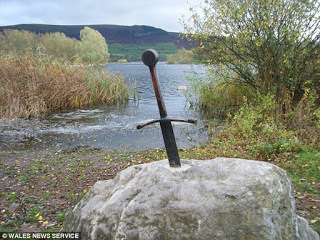
In Part One we talked about completing a novel, and what an amazing process that is. We used the analogy of pulling the sword from the stone, the stone representing the obstacles to writing; the sword the completed novel. Part One went on to look at the path of Traditional Publishing and what that means for an author. Here in Part Two, we will talk about being an Indie Author.
Again, this little post is not meant as a “How-to-Indie-Publish” manifesto. That task would far exceed the limits of this blog post. Rather, think of this as a sketch. Choosing to be an Indie Author does not mean treading a dragon-free path. The dragons are just different. Which brings us here. Sandwiched between Traditional Publishing and Vanity Publishing, Indie Authors have become a force in the book marketplace. Although the data is endlessly disputed and revised, revenue from purely Indie books make up somewhere around 40% of total books sales. That, my lovely writer friends, is a great deal of money. And, as any good fantasy book will tell us, dragons love to hoard treasure.
Most authors who choose to self-publish begin with the greatest dragon of them all: Amazon. So let us start there. First, just how big is this dragon anyway? The answer is that it is big; really, really big. According to Data-Guru Drew at K-Lytics, Amazon has more print books on hand than the Library of Congress. When we look at eBooks, the numbers get really staggering. There are somewhere in the range of five-million eBook titles on Amazon, with another 50,000-70,000 coming online every month. Now here comes the important bit: The top 50,000 books make up over 80% of the revenue on Amazon. That means the other four-million-nine-hundred-and-fifty-thousand (yes, I wrote that out on purpose!) books on Amazon, those below the top 50,000, earn less than 20% of the total revenue. The moral of these depressing statistics is that yes, Amazon will publish your book and, yes, your most precious novel will be adrift in a sea of other books.

“Forget the numbers,” you all shout. “We are brave authors on a quest! Forward!” Very well, onward we go. Before your manuscript can become an eBook, or Print-On-Demand Paperback, it has to be compiled. Compiling is the process of converting your manuscript into an accepted file format for uploading. Kindle Direct Publishing (KDP) is the side-kick dragon to the Amazon mega-dragon. KDP has a special type of file, a (dot)Mobi file. I write in Scrivener, a fantastic writing tool, which compiles directly to Mobi. Compiling a manuscript can be incredibly frustrating. Regardless of what tools you use, here is my first hard advice: Get Help!
One of the most amazing things about the path of the Indie Writer is the vast amount of help that is out there for the asking. Indie Writers love to write, and they love to write about the pitfalls, tribulations, and dragons of the writing and publishing process. Let’s say you are struggling (and you will) with compiling your manuscript into an eBook. The fonts are weird, or the spacing is all wrong, or the chapter headings are seriously wonky. This is your fifth try and you are ready to give it up and teach macramé to parrots. This is where you get help. Actually, it would have been better to get help before you (I) started. Yeah, I’m talking about myself now. Trust me, get help. Read first, learn, and only then compile.
Think of this as a stop at the armory, gathering our tools and weapons before we go further. There are folks who dedicate a great deal of time and effort toward helping Indie Authors, a fantastic army of bloggers who offer support and guidance. There are also folks who prey on the Indies and who, for a price, offer to save you from the horrors. Learn to tell the difference between the two. Here are some of the good guys: Joanna Penn is one of the shining stars along the path. Her Author 2.0 Blueprint is a must-read for Indies, and it’s free! Her website has been a huge resource for me. Mark Dawson’s Self-Publishing Formula is an amazing online course. There is free content and paid content. The point is that you are not alone. Someone, somewhere, has gone through the exact publishing issue you are experiencing, and they wrote a blog post about it. Again: Get Help!
We’ve checked the resources and we have done our homework, so let’s get to it. There is a good deal of work that must be done before we take on the actual KDP publishing process. We have to compile our manuscript to an upload file. We have to create a great book cover, or have someone create it. We are going to need a Book Blurb, some of the hardest writing you will ever do. Writing a fantastic book blurb is brutal. In the links section, I have listed two books that were invaluable to me. Libbie Hawker and Dean Wesley Smith saved my butt on the book blurb front. We need to research KDP Categories and Keywords. This is how we choose where our novel fits in the great matrix of Amazon. Prepare carefully, do the steps, and eventually you will come to the brink. You will press the ‘Publish’ button. If you have done all the steps correctly, guess what? Your novel is now an eBook.
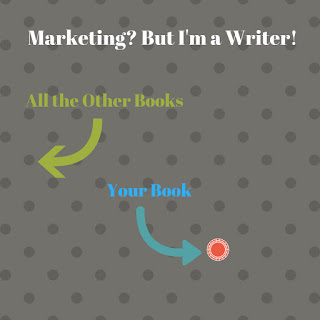
In Part One of this blog, I mentioned savoring the moment. Now would be a good time to do just that. Look at your newly published eBook, all shiny and bright on the Amazon page. Family and friends will buy your book, which is really cool. You will see sales on your very own KDP page. Now take a deep breath, and get ready for end of the parade. Once the Family-and-Friend pool has run dry, it’s time to roll up our sleeves and get to work.
This is paragraph nine, the evil little paragraph where I share a phrase you may grow to hate. That phrase is “Platform Building,” and it is one you will hear over and over. You will hear about it over and over because it is important. To emphasize, building a platform is vitally important. Remember when we were talking about the vast number of books on Amazon? Your novel is now one of those numbers, and most likely not near the top. In fact, hard truth time, if your novel is not in the Top 100 of a given Amazon Category, no one is going to see it. At all. Amazon is not going to market your book. Not even a little tiny bit. There are only two ways a potential reader is going to discover your book. One, they are specifically searching for it by title, like my Aunt Gloria (who really likes my novels) or, two, you have managed to get the idea of your novel onto the potential reader’s computer screen. Building a Platform, or Author Platform, is a series of steps, all of which you can do. I know this because I have done them. If I can do it, you can do it. Trust me when I say I kicked and screamed at some of the steps, but I did them.
Here is the down and dirty on Platform building. Keep in mind, each of these items could take up an entire blog post. The planks of your platform include ways readers can find you. You’re going to need a Facebook page dedicated to your new novel, and to future projects. This is not the FB page where you post cute kitten picture. A FB page is free, and you can build one in an hour. Don’t forget to set up your shop. On Amazon, you will have to build an Author Page. It’s easy and important. Browse the author pages of writers you admire. You’ll get the idea. Ditto for Goodreads. Make sure your new novel is on Goodreads. Go through every single option that Goodreads or Amazon offers and check every single one. Yes, you want to have a biography, a library, an Author Page, and a blog. Yes, yes, yes. This is all free stuff, so enjoy it and make it work for you. Each of these steps gets your novel and your name in front of potential readers.
The next thing that every serious author needs is a decent website. I sweated blood, inventing an entire new language of profanity in the process, but I eventually built a really nice website. Or so my Aunt Gloria says. Learn about SEO (Search Engine Optimization) and why you need it to push your website to the top of the Google search page. After you have a beautiful new website, you will need to read up on building a mailing list. Why do we want a mailing list? So we can connect with potential readers, readers whom we can point in the general direction of our shiny new novel. Here is one more hard truth, and a dirty little secret. Hard Truth: Getting potential readers to see your book, amongst the mass of other books, is the hardest thing about Indie Publishing. Dirty Little Secret: Even Traditionally Published Authors have to do this.
The thing is, the dirty little secret isn’t so secret. One of the items that literary agents will look for in a query is whether or not the requesting author has a website, a following, you guessed it: A Platform. They want to know that you are willing to pick up a big part of the marketing. In other words, you are going to hustle your novel one way or another. If you’re an Indie Author, you get to keep a higher percentage of the sales. The trouble is, there must be sales to get a percentage. Hence the mantra: “We are all in sales.”
This is the place where you breathe in, breathe out, and relax. Your novel does not have an expiration date. It is a wonderful creation of your imagination and hard work. Platform building does not happen overnight, just as you did not write your novel overnight. Work through the items, starting with the low-hanging fruit. Building an Author Page on Goodreads or Amazon is fairly painless. Both sites have a lot of self-help articles. At the tougher end of the spectrum are the tasks of building a website and then building a subscription mailing list for your website. It is prudent to have all of the planks in your platform built and in place before you publish your novel. Having said that, I acknowledge that the pull to publish is strong. My first novel went live while I was still in the middle of the platform building process and I survived.
You have written a book, done the hard work, and published your book. Knuckling down, you have built a fantastic Author Platform. This is so great! Give yourself a pat on the back. Now it is time to put the platform to work. We are ready to take the leap to advertising, and it is a big leap. This is where we step far outside the Friends-and-Family pool, reaching out to the readers who have never heard of our novel.
There are many ways to advertise your novel. Again, let’s start with the low-hanging fruit. First, learn about writing ad copy. This is harder than it sounds. For Goodreads or Amazon, an author has about 150 characters with which to sell their novel; not words, characters. Resources for learning the art of ad copy include the books listed below, and Mark Dawson’s website. There are many more. Try your hand at ad copy before you set yourself to launching an ad.
Goodreads and Amazon are good places to try your first ads. The ad billings are based on link clicks, and the click costs are relatively low. It is critically important to research audiences and ad keywords. This is how you get your great thriller novel in front of folks who like thrillers, rather than wasting time on readers who only enjoy romance novels. It is important to know that you are going to make mistakes. You will probably waste a little money, but it is all part of the learning curve. The learning curve is much gentler on Amazon and Goodreads. Gentler than what, you will ask. Gentler than the complex monster that is the Facebook Ads Manager.
There are books devoted to Facebook ads, blog sites for FB ads, and courses on how to craft a successful FB ad. There are companies that will promise, for a fee, to build you the perfect Facebook ad. Why? Because FB ads are serious business, complicated, and, if done improperly, can ruin an advertising budget. Mark Dawson is one of the gurus of Facebook ads. I would recommend checking out his online videos for advice on crafting and executing your first ad. Some of his most important advice is start small, limit your budget, and track the results. As you hone your ad copy, and find your best audience and keywords, you will start to see results. Things will go wrong, or you won’t get the results you expect. That is all part of the learning process.
Welcome to the path of being a published writer. If you’ve made the Traditional Publishing cut, my hat is off to you. Good Job! If you are now an Indie Author, welcome to the fold. It can be fun, rewarding, and frustrating, but you will learn an amazing amount of new things. Remember to keep writing! One of the most important planks in the Author Platform is to publish more books. I can tell you from personal experience that it is easy to let publishing and marketing interfere with your writing. First and foremost, we are writers. As Indie Authors, we may have to wear different hats. We can be marketers, crafters of ad copy, or promoters, but at our core, we are writers. Keep the writer hat firmly on your head. It looks really good on you.
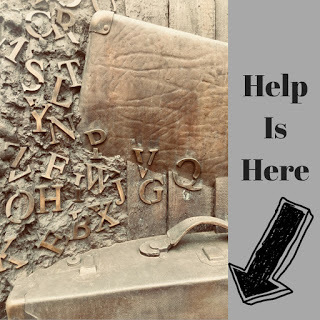
A Link for Joanna Penn’s The Creative Penn:
https://www.thecreativepenn.com/resources/
A Link for Mark Dawson’s Self-Publishing Formula:
https://selfpublishingformula.com/
A Link for K-Lytics (Alex the Data-Geek!)
http://k-lytics.com/
Gotta Read It by Libbie Hawker
How to Write Fiction Sales Copy by Dean Wesley Smith
Remember, you are not alone. The community of Indie Authors is pretty amazing. I cannot begin to thank all of the people who have helped me, either directly, or by providing information and insight on their blogs. As a way of paying back the rather large debt that I owe to the Indie Author community, I would like to make this small offer: If you are a first time author, or are struggling with one of the many facets of Indie Publishing, feel free to drop me a line. You can contact me through my website, which is listed at the end of this blog. If I can help you in any way, or steer you towards someone who can, I would be happy to do so. Thanks for reading!
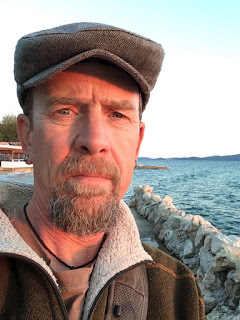
An ex-resident of Seattle, Marco Etheridge lives and writes in Vienna, Austria. He is the author of two novels: The Best Dark Rain: A Post-Apocalyptic Struggle for Life and Love and Blood Rust Chains. When he isn’t creating great fiction or being a good Hausmann, he explores the world with his lovely wife. If the sun is shining too brightly, or the birds are too chipper, Marco studies German grammar to create a suitably dark mood for creativity. For more information about his novels, check out his website at:
https://www.marcoetheridgefiction.com/
Published on June 13, 2018 11:26
June 6, 2018
The Sword in the Stone: Part One
This post was originally a guest post on Ashni Clayton's blog "Speaking Across the Centuries"
Here is a link to the original post on her website:
Speaking Across the Centuries
THE SWORD IN THE STONE:
PERILOUS JOURNEYS INTO THE WORLD OF PUBLISHING
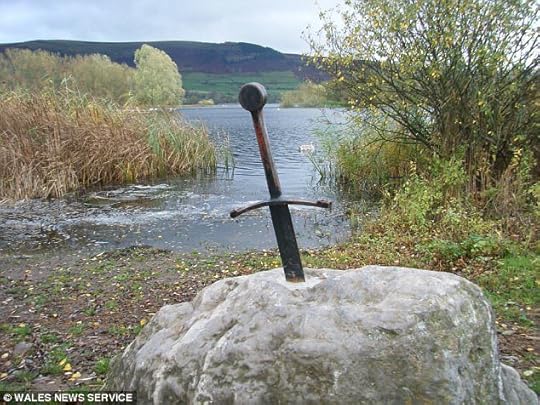
**********************************************************************
Part One: Traditional Publishing
Completing a novel is no small thing. It is like pulling the legendary sword from the stone. The stone represents all the things that hold one back as a writer; the sword is the completed novel. If you have actually finished your novel, savor the moment. Take pleasure in this story that you have brought to life. Heft the thing in your hand, feel its weight and balance. Prepare yourself for an entirely new journey, a new quest with your sword. That quest is the path of publishing.
Writing is, for the most part, a solitary affair. The writer and novel are insulated and safe, protected from the outside world. The process of writing is one of creativity, where anything is possible. The world of publishing is a much different place. Publishing is a business with one aim: Making money. Think of stepping into the world of publishing as embarking on a classic Hero’s Journey. Just as Joseph Campbell tells us, it may get a whole lot worse before it gets any better.In the past, the journey from completed novel to published novel was set in stone (pun intended). It consisted of writing a novel, finding a literary agent, who would then find a publisher. This process still exists and is generally referred to as Traditional Publishing. The past decade or so has seen the rise of another path, the path of the Indie Author. In Part One of this blog post, we will look at Traditional Publishing. Part Two will look at Self-Publishing, or being an Indie Author. This little post is not meant as a “How-to-Get-Published” manifesto. Rather, this is a cautionary tale of what dragons one can expect along the way. So on with Part One. Let’s get Traditional.

Let us assume that you have written the very best novel you can possibly write. The messy first draft is a distant memory, the rewrites have been hammered out, and the long hours of proofreading are over. If you are lucky enough to have a dedicated group of Beta-Readers, they have gone over your novel with the proverbial fine-toothed comb. This child of your creation, this amazing story, has now been edited, proofed, and read by your loyal and long-suffering friends. Your family, your friends, they all tell you that your novel should be published. They believe in you. The world is waiting for your story, and rightly so. The world needs more great stories.
The first step in Traditional Publishing is querying a literary agent. While being accepted by a literary agent does not mean that your novel will find a publisher, it is a huge first step. In some cases, an author may query directly to small indie presses, but the process remains basically the same. Queries begin with a top-notch query letter. There are many good online resources on how to write a good query letter. There are also a great many opinions as to what makes a query letter great, or damns it to a quick rejection. It is incumbent on the author to do his or her homework on the fine art of writing a query. This is your pitch, the three or four allotted paragraphs to sell your novel. The query is the one brief chance you will have to hook the person reading your query. I cannot possibly over-emphasize how important a well-crafted query letter is. Do your due diligence, do your homework, then write the query. There are many rules to the query process. The first rule of query letters: They have to be perfect. Not one typo, no missed punctuation, no misspellings. I beg you, ask someone to proofread your query letter. Please.
Oh, a word about rejection before going further. If you are determined to pursue this path, now is the time to grow a thick skin. Yes, I know that your novel is perhaps the greatest novel ever written. I know you believe in your novel and, quite frankly, I believe in your novel as well. Regardless, you will be rejected. The agent was having a bad day, the wind was from the south, whatever, it happens. Get used to it. Thick skin, remember? Thus girded for battle, onward!
Once one has the perfect query letter, one must have somewhere to send it. Now we must find agents who are accepting unsolicited queries. There are several very good online resources for researching agents. Agent Query and Publishers Marketplace are two of the best. The former is free and the latter is a paid subscription.
Agent Query
Publishers Marketplace
Finding appropriate agents to query is a process of elimination, and one of strict adherence to the requested documents. There is a great deal of information to be gleaned from most agent listings. First, is the agent open to submissions? Second, will they accept email submissions? What genres are they looking for? If you are a romance writer, do not submit your work to an agent interested in psychological thrillers. You will be wasting their time and yours. Every agent will require a slightly different submission package. They may require a synopsis, a three-chapter excerpt, both, or a query letter only. If one wishes to have any chance of success, the query package must be exactly what the agent is requesting, no more, no less. The agent will likely specify what format the synopsis or excerpts must be in. If they say they want everything in Twelve-point Times New Roman, double-spaced; they aren’t kidding. The query process is a multifaceted test. The test is not only whether or not an aspiring author can write. It is also a test of whether or not they can follow directions. Each letter must be personalized for the agent being queried, including the address of their agency and a reference as to why you chose to query that agent. Any query that begins with “Dear Agent” is most assuredly going to be filed in the round file. So we have our perfect query letter template, our synopsis, our excerpts, all the building blocks for a query package.
Not quite. Sorry. Agents want to see a motivated author. The last paragraph of a query is usually reserved for a short paragraph that is your curriculum vitae as a writer. If the agent manages to read to the end of your letter, they will look for some sign that you are motivated and ready to promote your work. This means having a clean, professional website, a current and active blog, or at least a social media page dedicated to your novel. Okay, last block in place: Ready, set, go!

Depending on the genre that one writes in, it is not unreasonable to compile a list of fifty or more agents. For my first novel, I sent out out many more queries than that. The list complied, the package perfect, it is time to begin mailing or emailing the submission packages. I suggest two things. The first suggestion is to keep a log of which agents were queried and when. Some form of notebook or file, whatever works best, will make it much easier to keep track of requests for additional information or rejections. Which brings us to suggestion number two. Now is the time to make use of the thicker skin we have girded our loins with. You are going to get rejection letters. They will sound personal, encouraging you to keep writing. After you receive a few more rejections, you will notice that they are all very similar. Another caution: do not, under any circumstances, send an angry or whiny reply to any agent. The world of publishing is small and word gets around. Thick skin, breathe deeply, move on.
Keep in mind that literary agents receive a great many unsolicited queries. These queries usually go into what is called a “Slush Pile.” The Slush Pile is often handled by an assistant. Your query package has to shine brightly enough to make it past the overworked eyes of the agent’s gatekeeper. A query may take weeks or months to claw its way to the top of the Slush Pile. Yes, months. Patience is a virtue you will need in great abundance. Once past this hurdle, the package may actually land in front of the agent. It will be Friday. For some reason, agents work on their Slush Piles on Fridays. Don’t ask me why.
At this point, there are three possible outcomes. The first is silence. Many agent listings state that the agency will only respond to queries that they are interested in. No response means no. The second possible outcome is said rejection letter. Invoke the mantra: Thick skin, breathe, move on. The last possible outcome, the joyous one, is a request for more information, perhaps even a request for a full manuscript.
If you are fortunate enough to receive a request for additional material, allow yourself the complete freakout. Go for it, ecstatic dance and everything. Once the joy dust settles, prepare your reply to the agent, sending them exactly what they are requesting, no more, no less. It is important to keep all of your replies professional, businesslike, and upbeat without gushing. A request for additional material does not mean your book will be picked up by a publisher, but it is a very hopeful sign.From here, the process becomes one of the more intricate steps, and more waiting. Perhaps the agent has, or will, request a full copy of your manuscript. The author sends off the manuscript and waits. Many agents will request exclusivity at this point, not wanting to waste time reading a manuscript that several other agents are reading. The agent may request substantive changes to the manuscript. Authors must choose to compromise or not. This dance may go on through several rounds, but, at some point, the agent will offer representation or bow out. Representation means the agent does the work of finding a publisher for the author’s manuscript. In return for that work, the literary agent will take 10-15% of domestic sales and 20% of foreign sales.
The reality of questing for publication is that only a very few debut authors will find an agent who will offer representation. Many now-famous authors were rejected hundreds of times as debut authors. There is no easy or soft way to say this; finding an agent is a long, tough, arduous process.But let us assume that one of our lucky few have broken through the barrier. There will be more waiting as the agent queries publishers. Yes, there is an upstream process between agent and publisher. When a publisher shows interest, there may be more requests for changes, either to manuscript, title, or both. The author’s agent should help with negotiating a publishing contract. Once the contract is inked, there will come a period of editing, proof-reading, cover design, and more. All of this takes time. Even with everything going smoothly, the process is not a speedy one.
These few brief paragraphs actually cover a journey that may take between eighteen months and two years. Allowing six months to find an agent is not an unreasonable guess. It could very well take longer. Add another six months for the agent to find a publisher and yet another six months for the publishing process. This would be the fast-track, the shortest distance between the first query letter and one’s published novel sitting happily on a bookstore shelf.
Our intrepid author, sword still in hand, has achieved the quest. What then? There are some very tangible benefits that come with Traditional Publishing. Prestige and recognition are some of the larger benefits. Our author will be eligible for literary prizes that Indie Authors generally are not. This is changing ever so slowly, but for the most part is still true. Our successful author can see his or her novel on the shelves of the local bookstore. The novel is much more likely to be reviewed by mainstream literary publications.
The publisher will, to a point, engage in marketing and promotion. For a debut author, that point will be fairly limited. The days of an author writing in seclusion and handing off manuscripts with no further thought are long gone. The popular mantra is “We are all in sales,” and no one more than the author. Expect to do a large part of your own marketing, traditionally published or not. And do not expect to get rich, or even very famous. The average advance for a debut author is about $8000. The agent will take their cut of this, plus most novels will not ‘earn out,’ meaning that the author will not receive anything more than the advance. As for getting famous, you will read stories of debut novelists winning a prestigious literary award and topping the New York Times bestsellers list. It does happen, but so do lightning strikes.
I do not mean to paint too grim a picture, nor do I wish to portray the world of publishing as any less brutal than it is. It is a tough business, to be sure. But with perseverance, a thick skin, and a great book, debut authors can and do succeed. But what if one simply cannot find an agent, or if one wants more control over the publishing process? That will carry us into Part Two, the world of Indie Publishing. Like Traditional Publishing, Indie Publishing has its own set of benefits, dragons, and trials.
************************************************************************
About the Author:
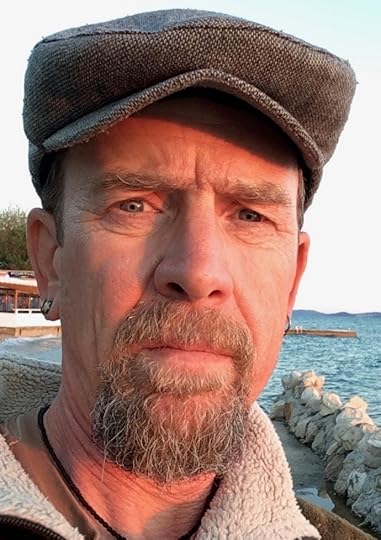
An ex-resident of Seattle, Marco Etheridge lives and writes in Vienna, Austria. He is the author of two novels: The Best Dark Rain: A Post-Apocalyptic Struggle for Life and Love and Blood Rust Chains . When he isn’t creating great fiction or being a good Hausmann, he explores the world with his lovely wife. If the sun is shining too brightly, or the birds are too chipper, Marco studies German grammar to create a suitably dark mood for creativity. For more information about his novels, check out his website at:
Marco Etherige Fiction
Here is a link to the original post on her website:
Speaking Across the Centuries
THE SWORD IN THE STONE:
PERILOUS JOURNEYS INTO THE WORLD OF PUBLISHING

**********************************************************************
Part One: Traditional Publishing
Completing a novel is no small thing. It is like pulling the legendary sword from the stone. The stone represents all the things that hold one back as a writer; the sword is the completed novel. If you have actually finished your novel, savor the moment. Take pleasure in this story that you have brought to life. Heft the thing in your hand, feel its weight and balance. Prepare yourself for an entirely new journey, a new quest with your sword. That quest is the path of publishing.
Writing is, for the most part, a solitary affair. The writer and novel are insulated and safe, protected from the outside world. The process of writing is one of creativity, where anything is possible. The world of publishing is a much different place. Publishing is a business with one aim: Making money. Think of stepping into the world of publishing as embarking on a classic Hero’s Journey. Just as Joseph Campbell tells us, it may get a whole lot worse before it gets any better.In the past, the journey from completed novel to published novel was set in stone (pun intended). It consisted of writing a novel, finding a literary agent, who would then find a publisher. This process still exists and is generally referred to as Traditional Publishing. The past decade or so has seen the rise of another path, the path of the Indie Author. In Part One of this blog post, we will look at Traditional Publishing. Part Two will look at Self-Publishing, or being an Indie Author. This little post is not meant as a “How-to-Get-Published” manifesto. Rather, this is a cautionary tale of what dragons one can expect along the way. So on with Part One. Let’s get Traditional.

Let us assume that you have written the very best novel you can possibly write. The messy first draft is a distant memory, the rewrites have been hammered out, and the long hours of proofreading are over. If you are lucky enough to have a dedicated group of Beta-Readers, they have gone over your novel with the proverbial fine-toothed comb. This child of your creation, this amazing story, has now been edited, proofed, and read by your loyal and long-suffering friends. Your family, your friends, they all tell you that your novel should be published. They believe in you. The world is waiting for your story, and rightly so. The world needs more great stories.
The first step in Traditional Publishing is querying a literary agent. While being accepted by a literary agent does not mean that your novel will find a publisher, it is a huge first step. In some cases, an author may query directly to small indie presses, but the process remains basically the same. Queries begin with a top-notch query letter. There are many good online resources on how to write a good query letter. There are also a great many opinions as to what makes a query letter great, or damns it to a quick rejection. It is incumbent on the author to do his or her homework on the fine art of writing a query. This is your pitch, the three or four allotted paragraphs to sell your novel. The query is the one brief chance you will have to hook the person reading your query. I cannot possibly over-emphasize how important a well-crafted query letter is. Do your due diligence, do your homework, then write the query. There are many rules to the query process. The first rule of query letters: They have to be perfect. Not one typo, no missed punctuation, no misspellings. I beg you, ask someone to proofread your query letter. Please.
Oh, a word about rejection before going further. If you are determined to pursue this path, now is the time to grow a thick skin. Yes, I know that your novel is perhaps the greatest novel ever written. I know you believe in your novel and, quite frankly, I believe in your novel as well. Regardless, you will be rejected. The agent was having a bad day, the wind was from the south, whatever, it happens. Get used to it. Thick skin, remember? Thus girded for battle, onward!
Once one has the perfect query letter, one must have somewhere to send it. Now we must find agents who are accepting unsolicited queries. There are several very good online resources for researching agents. Agent Query and Publishers Marketplace are two of the best. The former is free and the latter is a paid subscription.
Agent Query
Publishers Marketplace
Finding appropriate agents to query is a process of elimination, and one of strict adherence to the requested documents. There is a great deal of information to be gleaned from most agent listings. First, is the agent open to submissions? Second, will they accept email submissions? What genres are they looking for? If you are a romance writer, do not submit your work to an agent interested in psychological thrillers. You will be wasting their time and yours. Every agent will require a slightly different submission package. They may require a synopsis, a three-chapter excerpt, both, or a query letter only. If one wishes to have any chance of success, the query package must be exactly what the agent is requesting, no more, no less. The agent will likely specify what format the synopsis or excerpts must be in. If they say they want everything in Twelve-point Times New Roman, double-spaced; they aren’t kidding. The query process is a multifaceted test. The test is not only whether or not an aspiring author can write. It is also a test of whether or not they can follow directions. Each letter must be personalized for the agent being queried, including the address of their agency and a reference as to why you chose to query that agent. Any query that begins with “Dear Agent” is most assuredly going to be filed in the round file. So we have our perfect query letter template, our synopsis, our excerpts, all the building blocks for a query package.
Not quite. Sorry. Agents want to see a motivated author. The last paragraph of a query is usually reserved for a short paragraph that is your curriculum vitae as a writer. If the agent manages to read to the end of your letter, they will look for some sign that you are motivated and ready to promote your work. This means having a clean, professional website, a current and active blog, or at least a social media page dedicated to your novel. Okay, last block in place: Ready, set, go!

Depending on the genre that one writes in, it is not unreasonable to compile a list of fifty or more agents. For my first novel, I sent out out many more queries than that. The list complied, the package perfect, it is time to begin mailing or emailing the submission packages. I suggest two things. The first suggestion is to keep a log of which agents were queried and when. Some form of notebook or file, whatever works best, will make it much easier to keep track of requests for additional information or rejections. Which brings us to suggestion number two. Now is the time to make use of the thicker skin we have girded our loins with. You are going to get rejection letters. They will sound personal, encouraging you to keep writing. After you receive a few more rejections, you will notice that they are all very similar. Another caution: do not, under any circumstances, send an angry or whiny reply to any agent. The world of publishing is small and word gets around. Thick skin, breathe deeply, move on.
Keep in mind that literary agents receive a great many unsolicited queries. These queries usually go into what is called a “Slush Pile.” The Slush Pile is often handled by an assistant. Your query package has to shine brightly enough to make it past the overworked eyes of the agent’s gatekeeper. A query may take weeks or months to claw its way to the top of the Slush Pile. Yes, months. Patience is a virtue you will need in great abundance. Once past this hurdle, the package may actually land in front of the agent. It will be Friday. For some reason, agents work on their Slush Piles on Fridays. Don’t ask me why.
At this point, there are three possible outcomes. The first is silence. Many agent listings state that the agency will only respond to queries that they are interested in. No response means no. The second possible outcome is said rejection letter. Invoke the mantra: Thick skin, breathe, move on. The last possible outcome, the joyous one, is a request for more information, perhaps even a request for a full manuscript.
If you are fortunate enough to receive a request for additional material, allow yourself the complete freakout. Go for it, ecstatic dance and everything. Once the joy dust settles, prepare your reply to the agent, sending them exactly what they are requesting, no more, no less. It is important to keep all of your replies professional, businesslike, and upbeat without gushing. A request for additional material does not mean your book will be picked up by a publisher, but it is a very hopeful sign.From here, the process becomes one of the more intricate steps, and more waiting. Perhaps the agent has, or will, request a full copy of your manuscript. The author sends off the manuscript and waits. Many agents will request exclusivity at this point, not wanting to waste time reading a manuscript that several other agents are reading. The agent may request substantive changes to the manuscript. Authors must choose to compromise or not. This dance may go on through several rounds, but, at some point, the agent will offer representation or bow out. Representation means the agent does the work of finding a publisher for the author’s manuscript. In return for that work, the literary agent will take 10-15% of domestic sales and 20% of foreign sales.
The reality of questing for publication is that only a very few debut authors will find an agent who will offer representation. Many now-famous authors were rejected hundreds of times as debut authors. There is no easy or soft way to say this; finding an agent is a long, tough, arduous process.But let us assume that one of our lucky few have broken through the barrier. There will be more waiting as the agent queries publishers. Yes, there is an upstream process between agent and publisher. When a publisher shows interest, there may be more requests for changes, either to manuscript, title, or both. The author’s agent should help with negotiating a publishing contract. Once the contract is inked, there will come a period of editing, proof-reading, cover design, and more. All of this takes time. Even with everything going smoothly, the process is not a speedy one.
These few brief paragraphs actually cover a journey that may take between eighteen months and two years. Allowing six months to find an agent is not an unreasonable guess. It could very well take longer. Add another six months for the agent to find a publisher and yet another six months for the publishing process. This would be the fast-track, the shortest distance between the first query letter and one’s published novel sitting happily on a bookstore shelf.
Our intrepid author, sword still in hand, has achieved the quest. What then? There are some very tangible benefits that come with Traditional Publishing. Prestige and recognition are some of the larger benefits. Our author will be eligible for literary prizes that Indie Authors generally are not. This is changing ever so slowly, but for the most part is still true. Our successful author can see his or her novel on the shelves of the local bookstore. The novel is much more likely to be reviewed by mainstream literary publications.
The publisher will, to a point, engage in marketing and promotion. For a debut author, that point will be fairly limited. The days of an author writing in seclusion and handing off manuscripts with no further thought are long gone. The popular mantra is “We are all in sales,” and no one more than the author. Expect to do a large part of your own marketing, traditionally published or not. And do not expect to get rich, or even very famous. The average advance for a debut author is about $8000. The agent will take their cut of this, plus most novels will not ‘earn out,’ meaning that the author will not receive anything more than the advance. As for getting famous, you will read stories of debut novelists winning a prestigious literary award and topping the New York Times bestsellers list. It does happen, but so do lightning strikes.
I do not mean to paint too grim a picture, nor do I wish to portray the world of publishing as any less brutal than it is. It is a tough business, to be sure. But with perseverance, a thick skin, and a great book, debut authors can and do succeed. But what if one simply cannot find an agent, or if one wants more control over the publishing process? That will carry us into Part Two, the world of Indie Publishing. Like Traditional Publishing, Indie Publishing has its own set of benefits, dragons, and trials.
************************************************************************
About the Author:

An ex-resident of Seattle, Marco Etheridge lives and writes in Vienna, Austria. He is the author of two novels: The Best Dark Rain: A Post-Apocalyptic Struggle for Life and Love and Blood Rust Chains . When he isn’t creating great fiction or being a good Hausmann, he explores the world with his lovely wife. If the sun is shining too brightly, or the birds are too chipper, Marco studies German grammar to create a suitably dark mood for creativity. For more information about his novels, check out his website at:
Marco Etherige Fiction
Published on June 06, 2018 22:21
June 4, 2018
Book Review: "Born a Crime" by Trevor Noah
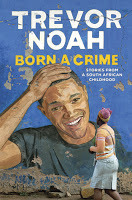
Born a Crime: Stories From a South African Childhood
by
Trevor Noah

Marco Etheridge's review Jun 04, 2018 · My Rating: Five Stars!!
Funny, poignant, and heart-breaking by turns, Trevor Noah's memoir "Born a Crime" is an enlightening journey into coming of age in South Africa. The fabric of his memories include the towering strength of his mother, the insanity of Apartheid, and being a downright naughty child.
By means of full disclosure, I have to say that I am a big Trevor Noah fan. I love the Daily Show, and I laugh myself silly watching Trevor Noah's comedy bits. Great stuff. Having said that, this memoir is cut from a different cloth. Funny, yes, but it is also powerful and deeply moving.
An added benefit of this memoir is an inside view of what Apartheid was, and how it impacted the lives of those living under those heinous government-imposed racial barriers. We are living in a time when, tragically, racial divides seem to be growing. "Born a Crime" serves as a milepost, and a reminder, of what racial injustice can to to a people, a family, and a childhood.
"Born a Crime" is well-written, funny, and poignant. What else can you ask of a memoir? Highly recommended.
Published on June 04, 2018 07:55
Review: "Father Figure" by James J. Cudney
 Father Figure by James J. Cudney
Father Figure by James J. CudneyMy rating: 4 of 5 stars
First, full disclosure, I was given a reader-copy by the author. This in no way alters my review. Second, James Cudney's novel "Father Figure" is far outside my normal reading genre. Regardless, I enjoyed the story, and was glad for the opportunity to read and review this novel.
"Father Figure" is a story of intersecting lives. It is a tale of two teenage girls, two different times, one family. There are family secrets, big family secrets, and the search for the truth. The plot moves back and forth between the two stories, one of a mother's past, the other of her daughter's present. As the novel progresses, the two stories intertwine. I am a big fan of intersecting stories, so that was a plus for this novel.
I admit to struggling, at first, to hear the writer's voice. Not far into the novel, however, the storyline pulled me in. I mean this as no discredit to the author. As I said, I am very far outside my normal genre with this novel. Once I settled in, I became engaged with the characters. I cared about what happened to them. As a reader, that is fundamentally important to me.
This is a tale of women. Strong women characters carry the plot line. It is a compliment to Mr. Cudney that he is able to craft a convincing female point of view. There was no point in the novel where I thought "This is a man writing about women." Well done indeed. The male characters in the novel, with a few exceptions, do not shine so brightly.
"Father Figure" is a family saga, made no less a saga because the family is a single mother and her daughter. The past and present collide, often with unforeseen results. The author addresses the issues of family secrets, sexuality, and yearning for the truth. One character locks away the past, the other seeks to uncover the truth of the past. This yearning for an identity, for a family landmark, carries the story forward.
I wish to extend my thanks to Jay for trusting me to read his work. I enjoyed "Father Figure" and look forward to other works by the author.
View all my reviews
Published on June 04, 2018 02:47
May 16, 2018
Advance Praise for "Blood Rust Chains"
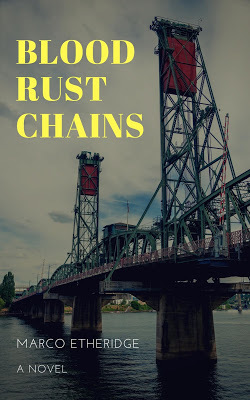 I am very pleased to announce the release of my second novel, "Blood Rust Chains." It is available on Amazon in both eBook and Paperback editions.
I am very pleased to announce the release of my second novel, "Blood Rust Chains." It is available on Amazon in both eBook and Paperback editions.No writer is an island unto himself, nor is any novel. As with my first novel, I have been fortunate enough to receive a great deal of help during the writing process. I am honoured and grateful to have had the support of my Beta-Reader Dark Army. Bless them every one!
Elena Deem, PhD, is one of the people I am most indebted to. She most graciously agreed to review an advance copy of my novel, and provided invaluable insight and comments. I wish to publicly thank her for taking the time to read and review my work. Ms Deem received an ARC of the novel prior to publication.
Elena Deem has earned her PhD in Comparative Literature from the University of Washington in 2008. She works as a freelance literary and art critic.
Blood Rust Chains by Marco Etheridge
Review by Elena Deem, PhD
Blood Rust Chains , Etheridge’s second book, is an inconspicuously powerful account of a struggle for inner peace in situations of conflict and loss of control. As its main character, Quinn, sweeps through the streets of Portland and faces his nemesis, the novella unfolds to deliver a strong, yet subtly forged message of redemption through self-reflection and honest ownership of one’s mistakes.
Revenge and redemption, inherent particularly to popular US fiction, are here reworked with a near Zen-Buddhist take that lifts the narrative out of recognizable genres, and deconstructs the possibility of a predictable ending. This makes for an exciting read that is simultaneously soothing and jagging as the author explores a range of popular genres (pop heroic fiction, detective story, love story), but skillfully pulls the rug from under the reader at the very moment she expects a familiar denouement.
Etheridge is a keen observer of all levels of social interactions, and a skilled writer who knows how to seamlessly join form with content to orchestrate authentic experience that also somehow stretches the boundaries of a relevant genre. He smoothly moves from one scene of social interaction to another, and from one genre to the next, citing historical accounts as well as WhatsApp messages. The story is brought to socially diverse yet quotidian contexts, digging deep into situations whose significance is never entirely predictable, and which force Quinn to see his own predisposition to conflict and violence.
At first, Quinn seems like an ordinary, freelance journalist. But Quinn has something street-and-working-class about him, and shows undue restraint when forced into a conflict. Yet, after his journalistic interest in the recent “genealogy craze” brings about an unexpected confrontation with the violent past of his own family, Quinn responds, which unleashes the ghosts from his own past.
Killing and death loom close once Quinn allows the Wild West family stories get under his skin, and he starts musing over the apparent differences between murder committed in revenge and in self-defense. In spite of himself, Quinn reacts to his belligerent neighbor, whose mission in life it is to provoke conflict. When the neighbor dies under suspicious circumstances, Quinn becomes the main suspect.
Confrontation and conflict, both literal and metaphoric, and their ethical ramifications, forge the central stage for the story. Unwillingly, Quinn is thrown into the ring to fight for his dignity and serenity through a series of precarious rounds of confrontation with different characters (the neighbor, police detectives, a mobster), that gradually increase in intensity. As in all good stories, the fight ultimately proves to be a matter of the character’s mind, rather than an act of physical violence unleashed onto the other (though Quinn does have a slip in the end); of taming the beast within with principle, courage, self-reflection, and guidance.
Blood Rust Chains foregrounds the premise that if there is anything like control over external situations, it is a matter of trained self-reflection; change can only happen from within. When Quinn loses his self-reflective defenses and slips, he immediately finds himself in a situation of immanent danger. This, of course, is a storyline well-known from the AA, and indeed, it turns out that Quinn is in a long-term recovery. Underpinning Quinn’s current situation is therefore another narrative that seems simpler and more solid: that of working the program. Etheridge’s writing is inherently clear-eyed; at times caustic and at others compassionate, he nevertheless presents a structure that ultimately disallows Quinn to be anything but brutally honest with himself.
Interestingly, this narrative setup causes that nearly all the characters in the novella, and Quinn’s interactions with them, serve as what might be called “Quinn’s truth posts.” Forefronted by Quinn’s partner—a lawyer whose ability to thoroughly examine and confront any gray areas in Quinn’ s honesty department is much needed—they help Quinn navigate and grow through his terrifying situation.
In the course, Quinn is forced to answer key questions that address the mechanisms of his perception of reality, and acknowledge his own responsibility to constantly check the truth of his states of being. After all, reality in the novella may be just that: whereas the exterior circumstances are beyond Quinn’s control, Quinn’s internal setup can be known—and so modified—by his acute awareness of his motives and triggers. This, in turn, may affect Quinn’s responses; a change in the usual behavioral pattern might prompt a minuscule shift in the direction of the unfolding events, which may be enough for Quinn to survive.
Blood Rust Chains is truly a story of a personal quest for redemption and inner peace, for removing what might be the “chains” of misperception and dishonesty that tie Quinn to his past. As the process concludes, Quinn feels that while this freedom might be temporary, the mechanisms of self-confrontation he has learnt are not. He is “ready for what comes. And if he felt those chains again, the chains of fear and anger, he would be ready for them as well.”
Published on May 16, 2018 05:05
May 9, 2018
Another review for: THE BEST DARK RAIN
I am very pleased and grateful to share another independent review of my novel The Best Dark Rain.This review comes from James J. Cudney, who probably has the best author name ever. Here is a link to his website, This Is My Truth Now:
This Is My Truth Now
Here is the Jay's full review:
Posted on May 9, 2018 Last month, I posted an author alert about a new writer I was planning to read… just finished his book and wanted to share my review. See the author alert post here.
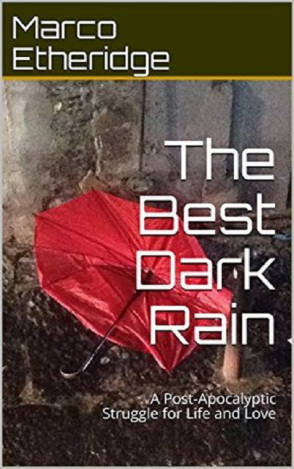
As a voracious reader, I sometimes find myself in a bit of a slump and need to test out a new genre, author, or writing style. When I came across The Best Dark Rain: A Post-Apocalyptic Struggle for Life and Love by Marco Etheridge, I thought to myself… you don’t read much science-fiction, you haven’t seen many zombie films, and you haven’t sampled much from a writer living in Austria. Let’s give it a chance! I liked the ‘Resident Evil’ and “The Day After Tomorrow” movies, and this kinda felt like a combination of those two flicks, except I think I’m not allowed to say the word ‘zombie’ as they are clearly named ‘Re-Ams’ by Mr. Etheridge — which I think is a fantastic idea! Let’s chat about my new experience…
Seattle. Some sorta apocalypse has occurred. There are corpses coming back to life. There are hunters and prey. Lots of guns. A couple of characters wandering the streets in search of food and supplies. How will they survive? What caused everything to happen? What’s still yet to come? Lots of questions start forming in my head in the first few chapters. Etheridge is smart. He doesn’t answer them for a long time. Instead, this newbie reader is investing in the characters as people rather than trying to attribute ‘former lives’ to them, as it’s all gone, so what does that matter, right? By mid-book, you begin to understand what likely happened and how the world succumbed to something unexpected. By then, you want to know what happens to the 5 or 6 main characters… of course there is lots of bashing and blood, a death or two, some light romance, and lots of comedy / witty commentary on life.
I am really glad I read the book. It pushed me out of my normal comfort zone (in a good way) in some parts, but in others, it was like a very typical fiction read for me. It was just a different world or setting, which made me wonder am I missing out by reading more science fiction and fantasy books. Time will tell… just like time will tell in Seattle if Liz and Pat, the main focus of the book, will get their answers and push forward in life despite the walking dead / not-so-dead coming after them. As they began meeting a few other survivors, knowing all along it’s hard to tell the difference anymore between who is dead and who is alive, you feel that suspense of who should they trust. I was kinda excited to see a variety of character types in the story (no spoilers, read it on your own please!) and Etheridge ingests lots of humor into them and their relationships. One of my faves is Formerly Rachel. Seriously… you have to wonder what that means, but it’s a fantastic play on words.
That said… what kept me reading was the extreme detail that is offered whether describing a setting, life choices, options, or emotions. There’s a lot going on in terms of plot and story, but the world-building is what made me turn the pages. I wanted to see descriptions of how life played out, where the food came from, who beat up who, what kind of turmoil they lived in. So… if you read in this genre, you’ll be pleased. If it’s new to you, take a chance like me. There’s a lot of reality coming forward and well, if the world ever does go this way, maybe we’ll know how to survive now, right? Thanks for pushing my reading boundaries, Mr. Etheridge. I look forward to reading more from you.
This Is My Truth Now
Here is the Jay's full review:
Posted on May 9, 2018 Last month, I posted an author alert about a new writer I was planning to read… just finished his book and wanted to share my review. See the author alert post here.

As a voracious reader, I sometimes find myself in a bit of a slump and need to test out a new genre, author, or writing style. When I came across The Best Dark Rain: A Post-Apocalyptic Struggle for Life and Love by Marco Etheridge, I thought to myself… you don’t read much science-fiction, you haven’t seen many zombie films, and you haven’t sampled much from a writer living in Austria. Let’s give it a chance! I liked the ‘Resident Evil’ and “The Day After Tomorrow” movies, and this kinda felt like a combination of those two flicks, except I think I’m not allowed to say the word ‘zombie’ as they are clearly named ‘Re-Ams’ by Mr. Etheridge — which I think is a fantastic idea! Let’s chat about my new experience…
Seattle. Some sorta apocalypse has occurred. There are corpses coming back to life. There are hunters and prey. Lots of guns. A couple of characters wandering the streets in search of food and supplies. How will they survive? What caused everything to happen? What’s still yet to come? Lots of questions start forming in my head in the first few chapters. Etheridge is smart. He doesn’t answer them for a long time. Instead, this newbie reader is investing in the characters as people rather than trying to attribute ‘former lives’ to them, as it’s all gone, so what does that matter, right? By mid-book, you begin to understand what likely happened and how the world succumbed to something unexpected. By then, you want to know what happens to the 5 or 6 main characters… of course there is lots of bashing and blood, a death or two, some light romance, and lots of comedy / witty commentary on life.
I am really glad I read the book. It pushed me out of my normal comfort zone (in a good way) in some parts, but in others, it was like a very typical fiction read for me. It was just a different world or setting, which made me wonder am I missing out by reading more science fiction and fantasy books. Time will tell… just like time will tell in Seattle if Liz and Pat, the main focus of the book, will get their answers and push forward in life despite the walking dead / not-so-dead coming after them. As they began meeting a few other survivors, knowing all along it’s hard to tell the difference anymore between who is dead and who is alive, you feel that suspense of who should they trust. I was kinda excited to see a variety of character types in the story (no spoilers, read it on your own please!) and Etheridge ingests lots of humor into them and their relationships. One of my faves is Formerly Rachel. Seriously… you have to wonder what that means, but it’s a fantastic play on words.
That said… what kept me reading was the extreme detail that is offered whether describing a setting, life choices, options, or emotions. There’s a lot going on in terms of plot and story, but the world-building is what made me turn the pages. I wanted to see descriptions of how life played out, where the food came from, who beat up who, what kind of turmoil they lived in. So… if you read in this genre, you’ll be pleased. If it’s new to you, take a chance like me. There’s a lot of reality coming forward and well, if the world ever does go this way, maybe we’ll know how to survive now, right? Thanks for pushing my reading boundaries, Mr. Etheridge. I look forward to reading more from you.
Published on May 09, 2018 12:22
April 21, 2018
Kindle Countdown Deal!
Countdown Deals CLICK HERE!
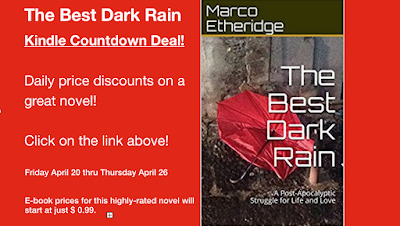
Countdown Deals CLICK HERE!
Hey Folks, a quick pause for the cause. Even a starving writer & vagabond needs to sell a few books. The Best Dark Rain is now available on a Kindle Countdown Deal. Prices for the eBook edition start at just $ 0.99, but they won't stay there long.
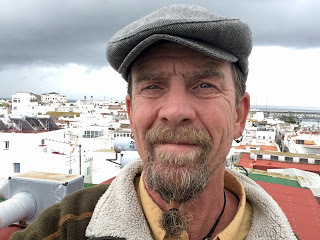
Thanks for reading! Have a great day.
Published on April 21, 2018 00:30
April 8, 2018
No Further
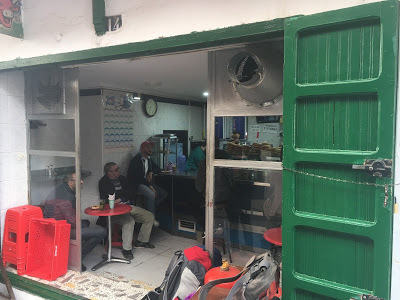 Brekkie in the Medina
Brekkie in the MedinaIn most journeys, there comes a point from which one will travel no further. We had come to that point. It was time to turn towards home.
It has been many years since I was on a journey that had no end point. There have been some, to be sure. When I was a teenager, roaming about the United States, I had no idea where I would end up. Life was the journey, and not in a metaphoric sense. Now I have a home to go back to, a life to lead, books to write. Truth be told, I was ready to go home. In the last two months I had slept only eight nights in my own bed. Nicaragua, Ecuador, Spain, Morocco; this has been a long trip.
A good travel day begins with a good breakfast. We squeezed into a local cubby-hole on our way out of the Medina. Braced with good café au lait and the usual Moroccan morning gluten feast, we were ready for the bus ride back to Tangier. From there, the ferry would carry us to Tarifa.
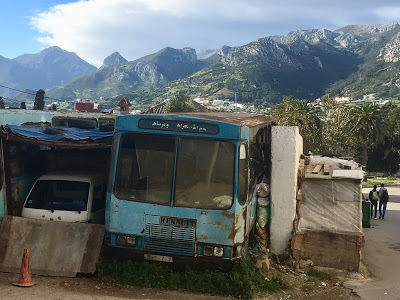
Broken Bus, Rif Mountains, Tétouan
We dropped out of the Medina, carrying our faithful backpacks. The modern city was awake and busy. The main bus station lies at the foot of the city, along the muddy river that runs to the Mediterranean Sea. Across the river, the Rif Mountains were bathed in morning sun. There was the usual shouting of the shills, the frantic energy of a busy bus station in a far-flung town. Without too much ado, we were on the bus and rolling north and west.
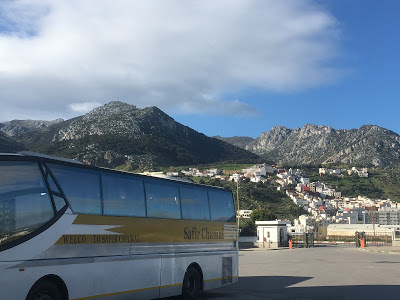 The Bus, the Rif
The Bus, the RifThe countryside rolled by, green with recent rains. The same donkeys bore burdens, the same goats grazed the verge of the highway. Eventually we passed back into Tangier, the route familiar now. Past the train station and rolling into the city, the bus slowed to a crawl on the clogged boulevards. And then we were there, back at the Tangier bus station.
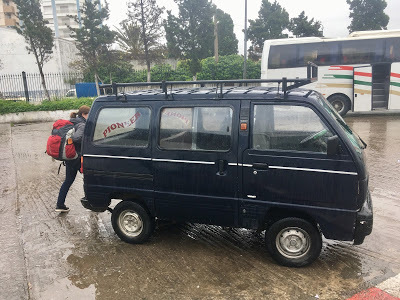
The Egg Van Taxi
Good travelers learn from prior experience. We were hoping to make the noon ferry to Tarifa. Based on our last trip across the Straits of Gibraltar, a one-hour ferry ride could easily turn into a four-hour ordeal. There was plenty of cushion in our schedule, just in case.
Regardless of our concerns, the Travel Gods smiled on us. We seldom take taxis, preferring to walk. But before we could take ten steps from our parked bus, a small man appeared. "Monsieur, Madame, taxi?" We inquired about the fare to the ferry, got a fair (sorry, really, accident, couldn't be helped) price of forty dirham, and were told to "wait, please." The man jogged off and, within moments, returned with the Egg Van. I could not believe our luck. These tiny Suzuki vans are a standard vehicle across Southeast Asia. The little vans were made somewhat famous in The No. 1 Ladies' Detective Agency, a series of novels by Alexander McCall Smith. Now we were going to get to ride in one!
It was as silly a vehicle as it looks, more rattle than substance, but we whisked along the waterfront to the ferry terminal. As we passed one of the Tangier locations for Jim Jarmusch's Only Lovers left Alive, I said a smiling Au Revoir to this great city. I will certainly be back.
 The Tangier-Tarifa Ferry, Sans Maniacal Crowd
The Tangier-Tarifa Ferry, Sans Maniacal Crowd And then everything went like clockwork. There were no huge crowds at the ferry, there was no long customs line. All was well. We made the noon ferry without issue, chopping across the rough seas, back to the European continent. One hour later, we were in Tarifa, Spain, far ahead of schedule. Spanish passport and customs was a breeze, and we found ourselves back on the cobbled streets of Tarifa. Some days it's easy, some days it's not.
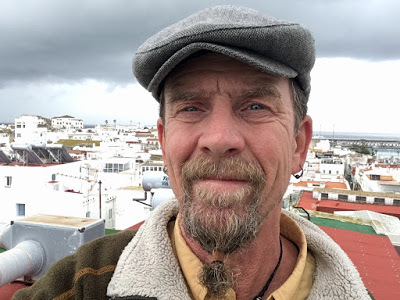 Strange Man, Tarifa
Strange Man, TarifaWe are come to Tarifa at the Easter weekend, the culmination of the Semana Santos. This was our one night of dropping some fairly serious dough on a hotel room. When we had left Tarifa, rooms were going for fifty euro and up. Booking ahead from Tétouan the best we could do was seventy euro. But for that, we had a charming little room and a great sun terrace. To our great wonder, Tarifa actually showed us the sun. The clouds broke, and the white-washed city was bathed in a Mediterranean glow. Even the normally howling winds subsided.
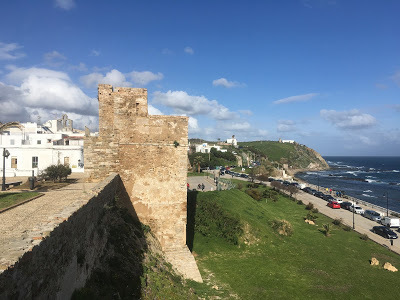
The narrow lanes of the old city were thronged with the pious and the not-so-pious. The pious, in their Easter best, were crowded around the churches for this holiest of weekends. The not-so-pious were enjoying the spectacle from one of the many crowded bars and cafés. The joint was jumping, and we decided to jump with it. Thee were snacks to be eaten, coffee to be drunk, and people to watch. Tarifa was showing us its gentle side, and life was good.
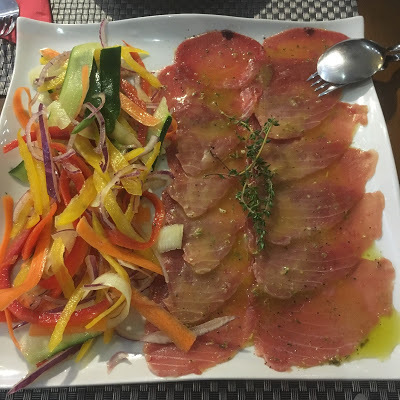 Carpaccio Atún
Carpaccio Atún Since we were paying the big euro prices for a hotel, we splurged on dinner. Finding an open table in the old city proved to be a futile endeavor. Just across from the ferry terminal, we found a sweet Italian joint. Not only were the staff Italian, but most of the diners seemed to be as well. It was busy, noisy, and smelled amazing. Bingo! Dinner found.
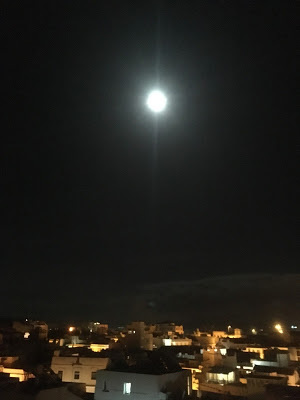
Another travel day spent, albeit with a minimum of stress. Tomorrow would find us on another bus, bound for Cádiz, and then a train to Dos Hermanas. For the nonce, we were enjoying the unexpected fruits of a warm Tarifa on a festive night.
From Tarifa, Spain, and homeward bound, it is time to say "Ciao for Now!"
Published on April 08, 2018 10:43
April 5, 2018
Far from the Madding Crowd
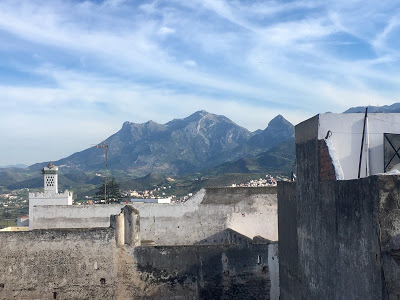 The Rif Mountains
The Rif MountainsTétouan falls into that strange category know as a Transfer City. These are places that travelers transfer through, bound for other destinations. In the case of Tétouan, that somewhere else is the tourist route between Tangier and Chechaouen. Folks arrive in Tangier, spend one night, then board the bus for the trip over the Rif Mountains to the blue-tinted town of Chechaouen. Nestled at the foot of the Rif, Tétouan is overlooked by most travelers. Their loss is my gain.
Thanks to publications like Lonely Planet and Rough Guides, there are now clearly established tourist routes where once there were little-known regions. Once upon a time, these routes were actually lonely and rough, the off-beat paths of backpack-toting sojourners. But times have changed. If a place is listed in the Lonely Planet guide, it is not going to be lonely. This is true across the globe, in South American, Southeast Asia, and even in North Africa. Stray but a little, however, off this well-documented pathway, and there remain quiet enclaves. By way of example, I remember one provincial town in Thailand, a town that will here go unnamed. Lonely Planet gave it a pass, excluding it from the tourist path. The two days I spent there were fabulous. There were very few Farrang, a fabulous market, and a great window on Thai culture. The same was true in the Mekong Delta region of Vietnam. Straying even twenty kilometers to either side of the well-worn route brought great rewards in the form of quiet villages, easy accommodations, and authentic markets not geared toward the tourist trade.
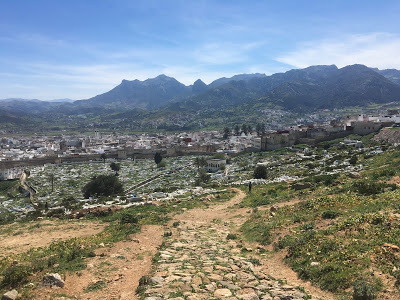 Tétouan sits in a river valley at the base of the Rif Mountains. From a rooftop in the Medina, one can see the Mediterranean to the north. The valley is dotted with small whitewashed villages, as are the foothills of the Rif. The town seems prosperous, with a busy modern center. Modern by Moroccan standards at any rate. There is an ancient fortress on the hill above the Medina, and the King of Morocco's summer palace at the foot of the hill. The modern town is a mix of colonial architecture, shop buildings, and blocky apartments.
Tétouan sits in a river valley at the base of the Rif Mountains. From a rooftop in the Medina, one can see the Mediterranean to the north. The valley is dotted with small whitewashed villages, as are the foothills of the Rif. The town seems prosperous, with a busy modern center. Modern by Moroccan standards at any rate. There is an ancient fortress on the hill above the Medina, and the King of Morocco's summer palace at the foot of the hill. The modern town is a mix of colonial architecture, shop buildings, and blocky apartments. 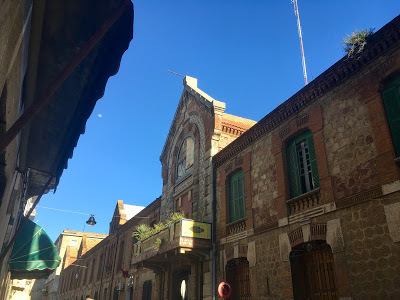 French Colonial buildings in the Modern City
French Colonial buildings in the Modern City This is a busy, bustling city. It is busy by day, and it is busy by night. As in Tangier, folks love to walk about in the evening, gathering in the shopping district, the cafés, or the public squares. Kids chase balls, parents push strollers, couples try to steal a bit of private time out of sight of their elders. Evenings in Tétouan are altogether enjoyable, whether strolling with the crowds in the modern city, or getting lost in the eerie tangle of the darkened Medina.

One of the Many Gates to the Medina
While the modern city has its charms, particularly the great cafés and restaurants, the star of the show is the Medina. The entire labyrinth is walled. One enters the maze through one of many arched gates. It is a very good idea to remember the location of at least some of the gates. This will come in handy when you get lost, and get lost you will. The Medina of Tétouan is one of the best preserved in all of Morocco. While one will see a few tourists, the Medina does not exist for them. This is a living, breathing space, inhabited and used by the local folk. To be sure, there are a few markets in the Medina that cater to the tourist trade. But the majority of the tiny stalls and shops are dedicated the needs of Moroccans.
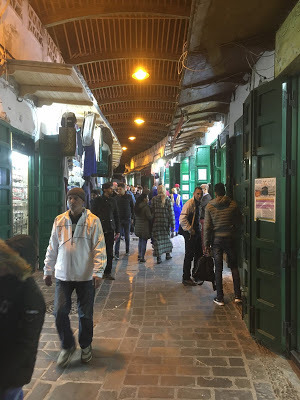 Night in the Medina
Night in the Medina To wander the Median at night is to enter an entirely new world, or a very old world. Some of the passageways are busy with folks running their evening errands. Bakeries the size of small closets are crowded with folks buying their breads and treats for dinner and tomorrow's breakfast. Half-hidden cafés give off the smell of mint tea and the voices of the men inside. There is the click of die, as unseen hands move tiles across traditional Parcheesi boards.
The landmarks that one established in the daytime Medina have all changed. Shops that were closed are open, those that were open closed. Light and shadow play across the intersections of narrow walkways. Covered passages are eerie, echoing with footsteps. We became completely lost, twice turned around, and thrice befuddled. It was wonderful. Evening in the Medina is eerie, and a bit spooky at times, but it is not scary. I do not mean to give the wrong impression. I never felt afraid, or hesitated to turn up this or that passageway. Otherworldly, yes. Scary, no.
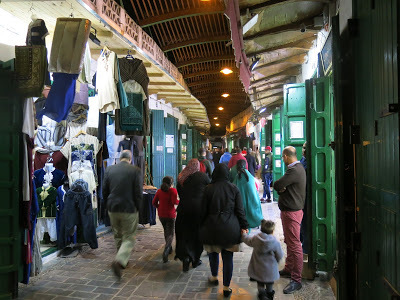
Busy Shoppers in the Medina
 Nightfall Looking Toward the Sea
Nightfall Looking Toward the Sea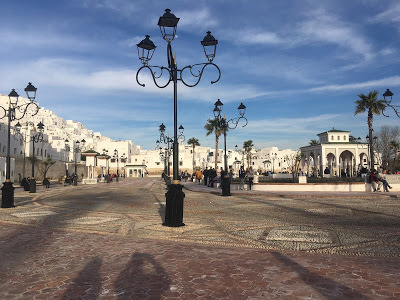
The Whitewashed Medina Behind a Public Square
Back in the modern town, thoughts turn to food. The traditional food of Morocco does not disappoint. In the north, there is a strong fusion of Moroccan, Spanish, and French cuisine. Paella is as common as couscous. Tangine, the Moroccan stew served in clay-ware, is always on the menu, and olives accompany every meal.
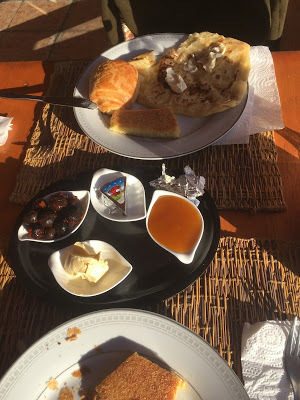 The Bane of the Gluten-Free Folks
The Bane of the Gluten-Free FolksBreakfast is all about baked goods. Roti, corn cakes, and savory rolls make up a traditional breakfast. There is butter, marmalade, and soft cheese to smear on ones yummy breadstuff. And, or course, olives. Coffee is good here in Morocco.The thick, black espresso is delivered to your table, while the waiter stands by to pour the hot Au Lait from his silver pitcher.
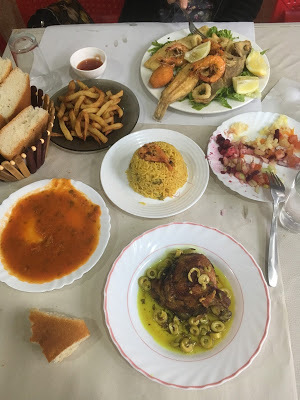 Stewed Chicken, paella, chopped salad, and fried fish make up a traditional meal in the north. There is always a basket of bread, as well as a saucer of some hot stew to dip into. Order all of the food you want. Diner for two rarely cost more than 120 dirham, or about thirteen dollars. We often ate for much less.
Stewed Chicken, paella, chopped salad, and fried fish make up a traditional meal in the north. There is always a basket of bread, as well as a saucer of some hot stew to dip into. Order all of the food you want. Diner for two rarely cost more than 120 dirham, or about thirteen dollars. We often ate for much less. 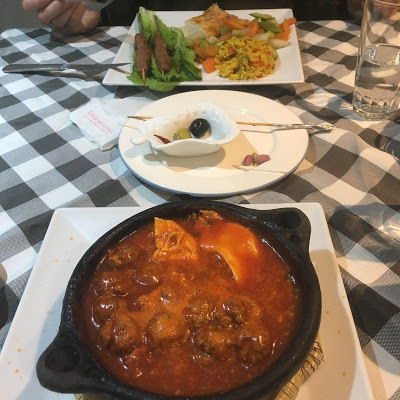
Tangine, the Traditional Moroccan Stew
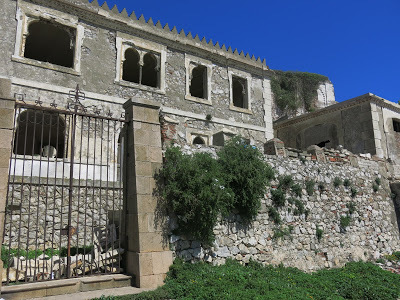
I love this town. Whether wandering in the heat of the day, or exploring at night, there is always some new thing to discover. If you are taken with hiking, there are trails in the Rif. The seaside is a short daytrip away. The modern city is a shoppers paradise, especially if one has small feet. My big feet prevented any great shoe bargains. The Medina is a maze of delight, a place that invites slow and thoughtful strolling. People smile and nod as you pass. Folks here are friendly and warm.
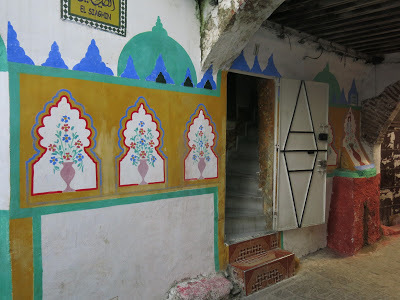 Color in the Medina
Color in the Medina An Open market Space at the Gloaming
An Open market Space at the Gloaming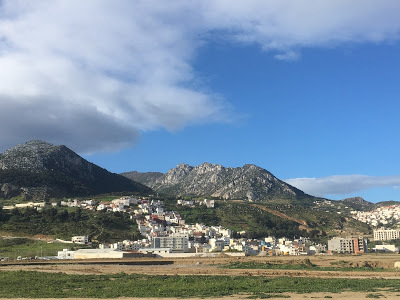 The Rif
The RifThree nights passed quickly, and we did not begrudge a single one of them. This Transfer Town, this place that people pass by, it suited me perfectly. Not everything was perfect, to be sure. Sleeping in any old city can be a challenge, whether Napoli or Tétouan. Stone walls and narrow passages magnify every sound. The Call to Prayer echos through the early morning before the sun rises. But that is why they invented earplugs. Don't leave home without them.
Stray off the path. Take a chance on a town that others pass by. Of course, it does not always go this way. Sometimes people have good reason not to stop. But Tétouan is not one of those places. It is charming, vibrant, beautiful, and very fun. I am still not going to tell you the name of the town in Thailand, but I suppose I have let the cat out of the bag on Tétouan. My bad.
So here is to over-looked towns, paths less traveled, and a tip o' the Rev Lid to Lonely Planet for steering folks in another direction. From Northern Morocco, it is time to say "Ciao for Now!"
Published on April 05, 2018 05:57



